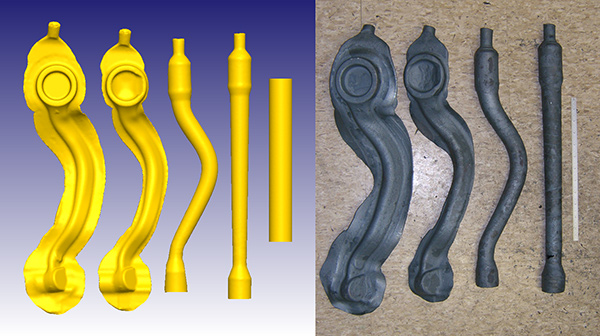Federally funded scientific research at American higher education institutions enables us to lead the world in technology and manufacturing.
By Andy Tang
For decades on the world stage, America has maintained a strong leadership position in scientific advancement, engineering innovation, and technological ingenuity. Since the Second World War, public sector investments in basic scientific research have provided American engineers with the tools and resources needed to discover new breakthroughs and pioneer industry-leading advancements. But today, amid steep cuts to federally funded university research, our nation’s engineering prowess is at considerable risk. We must maintain these investments to keep our competitive edge.
Government agencies offer a large number of competitive scientific research grants and programs. One lesser-known program that’s truly moving the needle for academia and for industry is the National Science Foundation’s (NSF) Engineering Research Center (ERC) Program, which supports a network of university-based, interdisciplinary research centers across the country. ERCs typically pursue high-risk, high-reward research in a wide array of technology fields – including advanced manufacturing, biotechnology, energy, microelectronics, and information technology. Each center is funded by the NSF for up to ten years, with additional investments from competitive and/or private programs. And the return on these long-term investments speaks volumes: Since the mid-1980s, NSF has funded a total of 83 ERCs across the United States, resulting in more than 250 spinoff companies, 920 patents, and 1,400 invention licenses.

Countless success stories have come out of ERCs across the country. The Ohio State University established a first-generation ERC in 1986 on the shaping and forming of metal components and the design and manufacture of tooling for these processes. The program provided significant technical value to Scientific Forming Technology Corporation (SFTC). SFTC’s DEFORM System is the United States’ premier Finite Element Modeling (FEM) software for metal forming process simulation. It has become the United States’ industry standard for the design of many manufacturing processes, such as those producing critical aircraft engine components, and it facilitates innovation in the multi-hundred-billion-dollar-per-year metal forming industry. SFTC now partners with Ohio State on a fourth-generation metal forming ERC – the Hybrid Autonomous Manufacturing – Moving from Evolution to Revolution (HAMMER), which designs advanced robotic blacksmithing processes that will help the United States re-shore manufacturing capabilities and create supply chain resilience.
At the University of Minnesota, the NSF ERC for Advanced Technologies for the Preservation of Biological Systems (ATP-Bio) strives to expand the lifespan and supply of organ transplants for patients in need. The center has pioneered a number of breakthrough cryopreservation technologies, including supercooling, partial freezing, isochoric, and vitrification, to improve the storage, shipment, and banking of organisms, organoids and transplantable organs for patients and research-ready organs for scientists. Through this work, ATP-Bio is changing the face of cryopreservation and organ preservation. Over the next five years, ATP-Bio will focus on creating a “cryo supply chain” of preserved organs to address the 2030 goals of President Trump’s 2019 Executive Order on Advancing American Kidney Health.
Another example, the Environmentally Applied Refrigerant Technology Hub (EARTH) ERC, led by the University of Kansas, is working to create sustainable and accessible refrigeration and air conditioning innovations that will improve the quality of life for all Americans and secure our leadership in workforce development and manufacturing. Supported by the NSF’s investment, EARTH is the only national research center dedicated to modernizing the heating, ventilation, air conditioning, and refrigeration (HVACR) industry and aims to enable the American Innovation and Manufacturing (AIM) Act to increase U.S. manufacturing by $39 Billion and generate 150,000 jobs.
Federal funding for science at American colleges and universities, like the NSF’s ERC program, prove a vital component to America’s research enterprise, not only for the companies they incubate, but also for the breakthrough discoveries they help originate and the brightest minds they train. American higher education research institutions step in to fill critical industry research gaps. They feed the future workforce pipeline of engineers and technologists. And on a larger scale, research universities help promote American competitiveness and improve American lives. In fact, government investments in scientific research and development have yielded economic returns of 150% to 300% since the post-World War II period.
Science is central to American life and the American economy. Federal outlays for scientific research at our colleges and universities position our nation as a world-class leader in science and technology and help us seize the tremendous economic benefits that come with that leadership position – including a strong annual GDP, sustained growth, and good paying jobs. To prevent competitors from overtaking our leadership position in critical fields and to maintain America’s unparalleled research enterprise, we must reverse proposed funding cuts and invest in the scientific, technological, and engineering efforts that underpin American exceptionalism.
About the Author:
Andy Tang serves as president of Scientific Forming Technology Corporation (https://www.deform.com/), a Columbus, Ohio-based company that provides state-of-the-art process simulation technology to the metal forming industry.
In this episode, I sat down with Beejan Giga, Director | Partner and Caleb Emerson, Senior Results Manager at Carpedia International. We discussed the insights behind their recent Industry Today article, “Thinking Three Moves Ahead” and together we explored how manufacturers can plan more strategically, align with their suppliers, and build the operational discipline needed to support intentional, sustainable growth. It was a conversation packed with practical perspectives on navigating a fast-changing industry landscape.